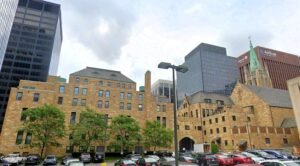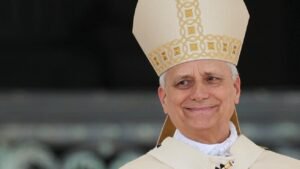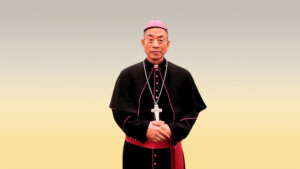The Clergy Crisis: Addressing the Manpower Shortage in the Catholic Church
Introduction
The Catholic Church is currently facing a significant decline in priestly vocations, a trend that is raising concerns among church leaders and congregants alike. In recent years, the number of seminarians has dwindled, resulting in a noticeable shortage of clergy to serve the faithful. According to the latest statistics from the Vatican, the number of priests worldwide has dropped by approximately 20% over the past three decades, with many regions experiencing even steeper declines. This downward trend is particularly pronounced in Western countries, where younger generations are increasingly disengaged from organized religion.
The reasons for this decline are multifaceted. Cultural shifts, changing societal values, and increased secularization have all contributed to a diminished interest in religious life. Factors such as the rise of individualism and a growing emphasis on personal fulfillment have led many potential candidates to seek fulfillment outside of traditional clerical roles. Additionally, the ongoing fallout from various scandals within the Church has created an environment of distrust, further deterring individuals from pursuing a vocation to the priesthood.
Moreover, the aging population of current priests exacerbates the crisis. Many priests are nearing retirement age, and with fewer new seminarians entering formation programs, the gap between retiring clergy and new ordinations continues to widen. Research indicates that, without significant intervention, some dioceses may face shortages severe enough to prevent them from offering essential sacramental services to the community.
The Catholic Church stands at a pivotal juncture, necessitating urgent attention to these trends and their implications. Addressing the decline of priestly vocations is vital for the Church’s future, as it affects not only the clergy but the entire faith community. In the following sections, we will explore the causes, consequences, and potential solutions to this pressing issue.
Understanding the Clergy Crisis
The clergy crisis in the Catholic Church is a multifaceted issue influenced by various societal, religious, and personal factors. One significant contributor is the profound societal changes that have taken place over the last several decades. As modern society has evolved, traditional norms surrounding religious vocations have also shifted, resulting in fewer individuals aspiring to become priests. Factors such as individualism, increased secularism, and a growing focus on personal autonomy have altered the perception of religious service, making it less appealing to potential candidates.
Shifting religious sentiments also play a crucial role in understanding the manpower shortage within the clergy. Many individuals today view religion as a personal choice rather than an obligation, leading to a decline in participation in religious practices, including Mass attendance. This decline has diminished the visibility and perceived relevance of the priesthood in everyday life, further deterring interested candidates from pursuing a vocation. Moreover, the increasing prominence of alternative spiritual practices and beliefs can create an environment where traditional Catholic roles are less respected or sought after.
Additionally, the challenges faced by those considering the priesthood have intensified. Prospective candidates are often met with concerns regarding financial stability, family expectations, and the potential for burnout. The contemporary image of priests has been further clouded by scandals, which can deter potential vocations from entering the ministry. This situation is compounded by geographical disparities; in some regions, such as parts of Europe and North America, the crisis is more pronounced, while areas like Africa and Asia may experience different dynamics and growth in priestly vocations.
Overall, understanding the clergy crisis requires an examination of these various factors, which collectively contribute to the ongoing manpower shortage within the Catholic Church.
Impact on Parishes and Communities
The decreasing number of priests within the Catholic Church has far-reaching consequences for both local parishes and the broader communities they serve. As the clergy shortage continues to persist, many parishes face the daunting challenge of operating with an insufficient number of ordained leaders. This reality often results in an increased workload for the remaining clergy members, who find themselves stretched thin while attempting to meet the spiritual needs of their congregations.
With fewer priests available to serve, parishes are compelled to consolidate resources and, in some situations, close their doors. The closure of a parish not only deprives a community of a place of worship but also disrupts the crucial social and spiritual fabric that these institutions provide. For many localities, churches serve as centers for community gatherings, charitable activities, and various forms of social support. The loss of such a cornerstone institution inevitably leads to diminished community engagement and increased isolation among residents.
Moreover, the decline in available clergy exacerbates the already limited access to vital sacraments and religious services that parishioners depend on for their spiritual growth. Baptisms, weddings, and funerals, which are significant landmarks in the lives of many Catholics, may become more difficult to arrange, leading to dissatisfaction among the faithful. As fewer priests can accommodate the voices of their congregations in times of need, feelings of disconnect may grow, resulting in potential declines in mass attendance and community participation in church functions.
Ultimately, the implications of the clergy shortage present a complex challenge that extends beyond the walls of the church and significantly impacts the lives of individuals within the community. The ongoing crisis necessitates immediate attention and innovative strategies to address the myriad issues arising from the diminishing presence of priests in parishes.
Merging and Closing Seminaries: A Sign of Trouble
The recent trend of merging and closing seminaries within the Catholic Church serves as a stark indication of the ongoing clergy crisis. This development is primarily driven by declining enrollment numbers, which challenge the very foundation of priestly formation. As fewer individuals express interest in pursuing the priesthood, the traditional model of seminary education faces significant strain. The repercussions of this trend extend beyond the walls of these institutions; they impact the broader health of the Church itself.
Seminaries have historically played a critical role in shaping the theological, pastoral, and spiritual competencies of future priests. By reducing the number of seminaries or consolidating them, the Church risks diluting the educational experience. This can lead to a one-size-fits-all approach, which may not adequately address the unique needs of various dioceses. As seminaries scale back, the diversity of priestly formation programs diminishes, potentially affecting how well future clergy can respond to the diverse challenges faced by local communities.
Moreover, the merging and closing of seminaries signal a deeper crisis of vocation. When young men opt not to enter the seminary, it raises concerns not only about the availability of sacraments but also about the spiritual health of future generations of Catholics. Fewer priests may lead to decreased access to pastoral care, teaching, and the sacraments, thus affecting congregational life and faith development among laypeople. The Church’s ability to engage effectively with contemporary societal issues—ranging from cultural shifts to moral questions—also risks being compromised as the priestly workforce dwindles.
In a time when the Catholic Church seeks to revitalize its mission and outreach, the trend of seminary mergers and closures highlights pressing challenges that must be addressed. By prioritizing the recruitment and education of future priests, the Church can work toward reversing this alarming trend and ensuring its vitality for years to come.
The Increased Burden on Existing Clergy
The ongoing clergy shortage within the Catholic Church has resulted in heightened responsibilities for existing priests. As many parishes are left without pastoral leadership, those still serving face the complex task of managing multiple congregations. The proliferation of parishes under one priest’s care can be overwhelming, often stretching resources and personnel to their limits. The phenomenon of balancing duties across various locations has given rise to significant concerns regarding workload and mental health within the clergy community.
Moreover, the increased demands imposed on priests can lead to a sense of burnout. In their pursuit to support their congregations and maintain spiritual guidance, many priests find themselves working long hours, often neglecting self-care and personal time. This situation is exacerbated during critical liturgical seasons, where the need for services and community engagement spikes, thereby doubling the workload for clergy already stretched thin.
The emotional toll associated with such heightened responsibilities is another critical concern. Overburdened priests may experience feelings of inadequacy and frustration as they struggle to meet the diverse needs of their parishioners. The necessity to address pastoral care, administrative responsibilities, and community outreach simultaneously can lead to an environment that is not only stressful but can also undermine the very essence of their vocation. Instances of anxiety and depression can surface, prompting a need for adequate support systems for these clergymen.
In light of these challenges, many clergy members advocate for a reevaluation of the current staffing models within the Church. Understanding the pressing nature of their circumstances and the need for systemic reforms could provide pathways toward alleviating the burdens currently borne by existing clergy. Addressing these issues is essential for sustaining the Church’s mission and the well-being of its priests.
Community Responses: Innovative Solutions to Address the Crisis
The current clergy crisis, characterized by a significant shortage of priests, has prompted innovative responses from various communities and dioceses. These initiatives aim not only to sustain spiritual guidance within parishes but also to cultivate broader participation among the faithful. Lay leadership initiatives have emerged as a prominent solution, allowing laypersons to take on leadership roles traditionally held by priests. This empowers community members to engage more actively in their faith and provides crucial support to parishes facing dwindling priest numbers.
Collaborative ministry models represent another effective approach to addressing this challenge. By fostering partnerships between parishes, dioceses can share resources and priestly assignments, maximizing the impact of existing clergy. This collaboration can involve co-celebrating Masses, sharing educational programs, or pooling resources for community outreach. Such strategies not only alleviate the burden on individual parishes but also strengthen the sense of unity and cooperation among church communities.
Several dioceses have successfully integrated technology into their ministry efforts, further demonstrating innovative approaches to the clergy shortage. Online Mass services, virtual prayer groups, and faith formation programs offer flexible options for parishioners. This adaptation has allowed individuals to stay connected to their faith despite physical barriers, making spiritual guidance more accessible. Moreover, these digital platforms encourage wider participation and dialogue among community members, fostering a more profound sense of belonging.
Finally, some dioceses have initiated mentorship and formation programs aimed at inspiring new vocations. By highlighting the joys and fulfillment associated with priestly service, these efforts can attract younger generations to consider the priesthood. Schools, universities, and parish outreach programs play a vital role in nurturing these younger individuals’ spiritual growth and potential calling. Together, these community responses showcase a multifaceted approach to addressing the existing manpower shortage in the Catholic Church.
The Role of the Laity in the Future of the Church
As the Catholic Church faces an unprecedented clergy crisis characterized by a tangible shortage of priests, the role of the laity has become increasingly prominent. Laypeople, who make up the majority of the Church’s membership, are now stepping into essential roles that have long been occupied by ordained clergy. This shift is not only necessary but could also usher in a new era of community engagement and spiritual vitality within the Church.
One of the primary areas in which the laity can significantly contribute is pastoral care. In many parishes, lay volunteers are emerging as vital supports to priests, especially in providing outreach to vulnerable populations, organizing community events, and offering emotional and spiritual support during times of crisis. As laypeople facilitate these activities, they embody the Church’s mission of service and compassion, fostering a sense of belonging that is crucial for healthy parish life.
Community leadership is another essential sphere where laypeople can take an active role. With fewer priests available to manage parish activities and congregations, lay leaders may assume responsibilities such as coordinating liturgical celebrations, leading prayer groups, or engaging in social justice initiatives. This increased involvement can lay the groundwork for a vibrant and effective leadership model that transcends traditional boundaries of clergy and laity, emphasizing a shared responsibility for the mission of the Church.
Moreover, the laity can provide spiritual guidance in ways that resonate with today’s faithful. By sharing personal experiences, offering mentorship, and leading faith-sharing discussions, lay leaders can create nurturing environments in which individuals and families can deepen their spiritual lives. This aspect of laity engagement effectively broadens the reach of the Church’s mission and strengthens its communal ties, making faith more accessible.
In this context, the active participation of laypeople not only addresses immediate challenges faced by the Church, such as the shortage of priests but also cultivates a more inclusive and supportive Church community, fostering a sense of shared mission among all members.
The Importance of Vocational Promotion
In recent years, the Catholic Church has been facing a significant manpower shortage, underscoring the need for effective vocational promotion. Encouraging young people to consider the priesthood as a meaningful calling is essential. This involves developing awareness among the youth about the nature and role of the priesthood, as well as the unique responsibilities it entails. Vocational promotion is not merely an invitation to consider priesthood; it is an active effort to shape a culture that values and nurtures vocations.
Parishes and dioceses are implementing various strategies to foster an environment conducive to growth in religious life. One effective approach has been the organizing of youth retreats and discernment programs, where young individuals are provided with opportunities to engage in prayer, reflection, and discussions with priests and religious leaders. These events create a space for open dialogue about the joys and challenges of a life dedicated to God, allowing participants to explore their faith in a supportive community.
Moreover, the incorporation of vocational awareness into Catholic education is vital. Schools affiliated with the Church play a crucial role in integrating discussions about vocations into their curricula. Educators and spiritual leaders collaborate to emphasize the importance of discernment in the lives of students. Providing resources that focus on the diversity of vocations—be it the priesthood, religious life, or lay ministry—allows students to appreciate the various paths available within the Church.
Community involvement is another significant factor in promoting vocations. Engaging families and local parishioners fosters a culture of support for young people contemplating their future in the Church. Encouraging mentorship, where experienced clergy share their journeys with young individuals, can further ignite interest in the priesthood. By fostering a vibrant culture centered around vocational promotion, the Catholic Church can inspire the next generation to embrace their calling with passion and dedication.
Conclusion: The Hope of a New Generation of Priests
The Catholic Church has faced significant challenges in recent decades, particularly concerning the availability of clergy. However, a persistent belief endures among the faithful that God continues to call individuals to serve as priests, even amidst this decline. This conviction is not merely wishful thinking; it reflects the Church’s resilience and the unbroken spirit of its mission.
New generations of potential priests may emerge from various backgrounds, driven by a profound commitment to their faith and community. The Church must actively engage with young people, presenting the priesthood as a viable and rewarding vocation. By creating an environment in which discussions about faith and service are encouraged, the Church can foster a renewed interest in priestly life. Programs that highlight the transformative impact of a priest’s role in society could inspire many to consider this sacred calling.
Additionally, the implementation of mentorship initiatives can play an instrumental role in nurturing future vocations. By pairing aspiring priests with seasoned clergy, the Church can provide invaluable support and guidance. Such relationships can enrich the spiritual and practical understanding of priesthood, ultimately allowing the new clergy to flourish in their service to the congregation.
Moreover, an emphasis on diverse expressions of faith can attract a wider array of candidates to the clergy. This inclusivity can resonate with modern youths who seek meaningful engagement within their spiritual life. It is, therefore, crucial for the Church to remain proactive in its outreach strategies and planning for the future.
In conclusion, while the current manpower shortage poses challenges, the unwavering conviction that God continues to call individuals to the priesthood offers hope. By embracing new approaches, fostering connections, and maintaining a focus on inclusive practices, the Catholic Church can inspire a new generation of priests to step forward and serve its flock faithfully.










